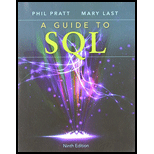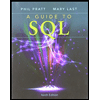
A Guide to SQL
9th Edition
ISBN: 9781111527273
Author: Philip J. Pratt
Publisher: Course Technology Ptr
expand_more
expand_more
format_list_bulleted
Concept explainers
Question
Chapter 4, Problem 13TD
Program Plan Intro
“SELECT” command:
The “SELECT” command is used to retrieve data in a
Syntax for selecting values from the table is as follows:
SELECT STUDENT_ID FROM STUDENT;
- The given query is used to display each student ID from “STUDENT” table.
“ORDER BY” Clause:
- User can sort the data in specific order using “ORDER BY” clause.
- The column on which to sort data is called a sort key or a simple key.
- To sort the output, use an “ORDER BY” clause followed by the sort key.
- If the user does not specify a sort order, the output displayed in default order that is ascending order.
Example:
The example for “ORDER BY” clause is given below:
SELECT STUDENT_ID, STUDENT_NAME, STUDENT_CREDIT FROM STUDENT ORDER BY STUDENT_CREDIT;
The above query is used to list student ID, name, and credit for each student with ascending order of student credit using an “ORDER BY” clause.
- From the given query, the sort key is “STUDENT_CREDIT”. So, the rows are sorted in ascending order by “STUDENT_CREDIT”.
Expert Solution & Answer
Want to see the full answer?
Check out a sample textbook solution
Students have asked these similar questions
Outline the overall steps for configuring and securing Linux servers
Consider and describe how a mixed Operating System environment will affect what you have to do to protect the company assets
Describe at least three technologies that will help to protect CIA of data on Linux systems
Node.js, Express, Nunjucks, MongoDB, and Mongoose
There are a couple of programs similar to this assignment given in the lecture
notes for the week that discusses CRUD operations. Specifically, the Admin
example and the CIT301 example both have index.js code and nunjucks code
similar to this assignment. You may find some of the other example programs
useful as well. It would ultimately save you time if you have already studied
these programs before giving this assignment a shot. Either way, hopefully
you'll start early and you've kept to the schedule in terms of reading the lecture
notes.
You will need to create a database named travel using compass, then create a
collection named trips. Use these names; your code must work with my
database. The trips documents should then be imported unto the trips collection
by importing the JSON file containing all the data as linked below. The file itself
is named trips.json, and is available on the course website in the same folder as
this…
using r language
Chapter 4 Solutions
A Guide to SQL
Ch. 4 - Prob. 1RQCh. 4 - Prob. 2RQCh. 4 - Prob. 3RQCh. 4 - Prob. 4RQCh. 4 - Prob. 5RQCh. 4 - In which clause would you use a wildcard in a...Ch. 4 - Prob. 7RQCh. 4 - How do you determine whether a column contains one...Ch. 4 - Prob. 9RQCh. 4 - Prob. 10RQ
Ch. 4 - Prob. 11RQCh. 4 - Prob. 12RQCh. 4 - Prob. 13RQCh. 4 - Prob. 14RQCh. 4 - Prob. 15RQCh. 4 - Prob. 16RQCh. 4 - How do you find rows in which a particular column...Ch. 4 - Use the Internet to research the SQL [charlist]...Ch. 4 - Prob. 1TDCh. 4 - Prob. 2TDCh. 4 - Prob. 3TDCh. 4 - Prob. 4TDCh. 4 - Prob. 5TDCh. 4 - Prob. 6TDCh. 4 - Prob. 7TDCh. 4 - Prob. 8TDCh. 4 - Prob. 9TDCh. 4 - Prob. 10TDCh. 4 - Prob. 11TDCh. 4 - Prob. 12TDCh. 4 - Prob. 13TDCh. 4 - Prob. 14TDCh. 4 - Prob. 15TDCh. 4 - Prob. 16TDCh. 4 - What is the price of the least expensive item in...Ch. 4 - Prob. 18TDCh. 4 - Prob. 19TDCh. 4 - Prob. 20TDCh. 4 - Prob. 21TDCh. 4 - Prob. 22TDCh. 4 - Prob. 23TDCh. 4 - Prob. 1CATCh. 4 - Prob. 2CATCh. 4 - Prob. 3CATCh. 4 - Prob. 4CATCh. 4 - Prob. 5CATCh. 4 - Prob. 6CATCh. 4 - Prob. 7CATCh. 4 - Prob. 8CATCh. 4 - Prob. 9CATCh. 4 - Prob. 10CATCh. 4 - Prob. 11CATCh. 4 - Prob. 12CATCh. 4 - Prob. 13CATCh. 4 - Prob. 14CATCh. 4 - Prob. 15CATCh. 4 - Prob. 16CATCh. 4 - Prob. 17CATCh. 4 - Prob. 18CATCh. 4 - Prob. 19CATCh. 4 - List the reservation ID and trip ID for all trips...Ch. 4 - Prob. 1SCGCh. 4 - Prob. 2SCGCh. 4 - Prob. 3SCGCh. 4 - Prob. 4SCGCh. 4 - Prob. 5SCGCh. 4 - Prob. 6SCGCh. 4 - Prob. 7SCGCh. 4 - Prob. 8SCGCh. 4 - Prob. 9SCGCh. 4 - Prob. 10SCGCh. 4 - Prob. 11SCGCh. 4 - Prob. 12SCGCh. 4 - Prob. 13SCGCh. 4 - Prob. 14SCGCh. 4 - Prob. 15SCGCh. 4 - Prob. 16SCG
Knowledge Booster
Learn more about
Need a deep-dive on the concept behind this application? Look no further. Learn more about this topic, computer-science and related others by exploring similar questions and additional content below.Similar questions
- using r languagearrow_forwardusing r languagearrow_forwardWrite a short paper (1 page/about 500 words) summarizing what we as System Admins can do to protect the CIA of our servers. Outline the overall steps for configuring and securing Linux servers Consider and describe how a mixed Operating System environment will affect what you have to do to protect the company assets Describe at least three technologies that will help to protect CIA of data on Linux systems Required Resourcesarrow_forward
- using r language Estimate the MSE of the level k trimmed means for random samples of size 20 generated from a standard Cauchy distribution. (The target parameter θis the center or median; the expected value does not exist.) Summarize the estimates of MSE in a table for k= 1,2,...,9arrow_forwardusing r language Estimate the MSE of the level k trimmed means for random samples of size 20 generated from a standard Cauchy distribution. (The target parameter θis the center or median; the expected value does not exist.) Summarize the estimates of MSE in a table for k= 1,2,...,9arrow_forwardusing r language The data law82 in bootstrap library contains LSAT and GPA for 82 law schools. Compute a 95% bootstrap t confidence interval estimates for the correlation statisticsarrow_forward
- using r language The data law82 in bootstrap library contains LSAT and GPA for 82 law schools. Compute a 95% bootstrap t confidence interval estimates for the correlation statisticsarrow_forwardusing r langauge The data law82 in bootstrap library contains LSAT and GPA for 82 law schools. Compute and compare the three 95% bootstrap confidence interval estimates for the correlation statistics.arrow_forwardWhat is the number of derangements of size k from the set {1,2,...n} to the set {1,2,...n} so that f(x) != x exactly k times with 1 <= k <= narrow_forward
- Trace a State Space Tree introduced in the Chapter 5.1 using algorithms depth_first_search (page 205), checknode (page 207), and expand (page 210). Assume that State Space Tree is a two-level full binary tree (root is level 0). Node #2 (according to notation used in the Figure 5.1, page 204) is non-promising. Count the number of steps performed by each of those three algorithms. Consider execution of instructions like "visit node" or execution of "promising function" as one step, "write a solution" as an exit call. Note: no need to print or a draw a whole tree. Just provide three numbers as an answerarrow_forwardParking Tickets Table St ID L_Name ☐ F_Name Phone_No St_Lic Lic_No Ticket# Date Code Fine 38249 38249 82453 Green 82453 Green 82453 Green Brown Thomas 111-7804 FL BRY 123 15634 10/17/06 2 $25 Brown Thomas 111-7804 FL BRY 123 16017 11/13/06 1 $15 Sally 391-1689 AL TRE 141 14987 10/05/06 3 $100 Sally 391-1689 AL Sally 391-1689 AL TRE 141 TRE 141 16293 11/18/06 1 $15 17892 12/13/06 2 $25 The functional dependencies are: St_ID → L_Name, F_Name, Phone_No, St_Lic, Lic_No St_Lic → Lic_No Code → Fine St_ID, Ticket # → Date 1. In what normal form is the relation?| 2. Convert PARKING TICKET to a set of 3NF relations.arrow_forwardIn excel, What does sorting mean? In excel, What does filtering mean? What are three advantages of converting a range in Excel to a table and List the steps involved in creating a table in Excel if you were using the range A7:G34arrow_forward
arrow_back_ios
SEE MORE QUESTIONS
arrow_forward_ios
Recommended textbooks for you
 A Guide to SQLComputer ScienceISBN:9781111527273Author:Philip J. PrattPublisher:Course Technology Ptr
A Guide to SQLComputer ScienceISBN:9781111527273Author:Philip J. PrattPublisher:Course Technology Ptr Np Ms Office 365/Excel 2016 I NtermedComputer ScienceISBN:9781337508841Author:CareyPublisher:Cengage
Np Ms Office 365/Excel 2016 I NtermedComputer ScienceISBN:9781337508841Author:CareyPublisher:Cengage

A Guide to SQL
Computer Science
ISBN:9781111527273
Author:Philip J. Pratt
Publisher:Course Technology Ptr


Np Ms Office 365/Excel 2016 I Ntermed
Computer Science
ISBN:9781337508841
Author:Carey
Publisher:Cengage